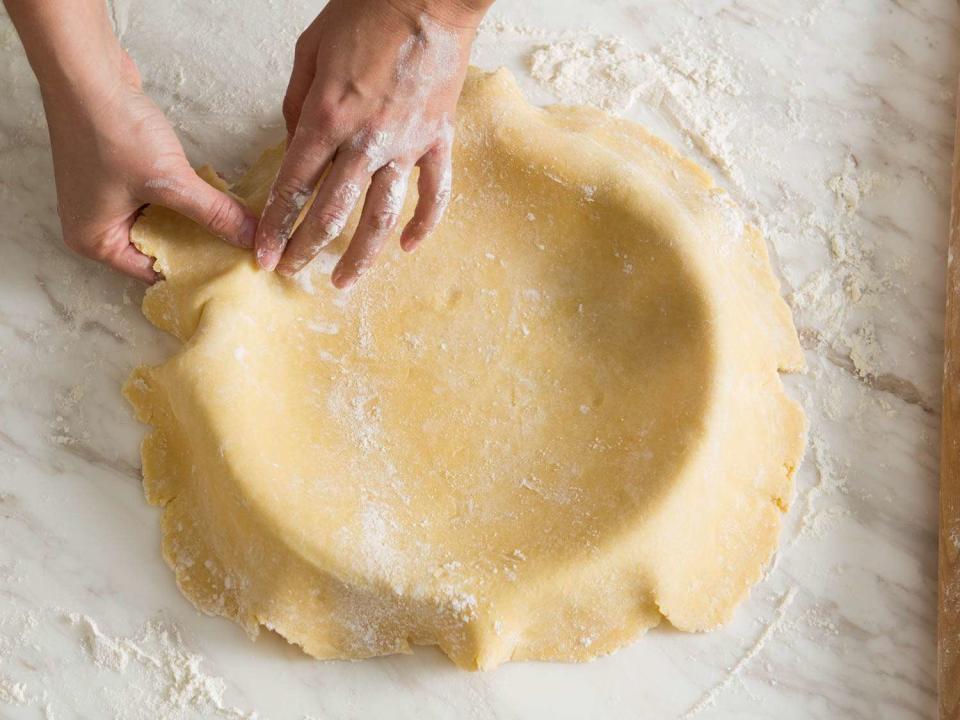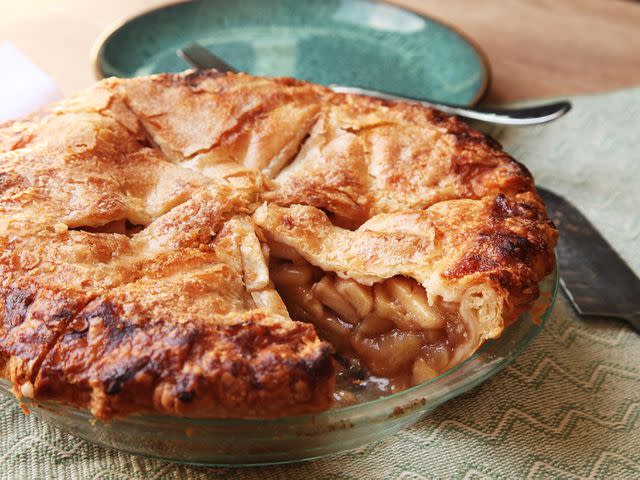2 Easy Pie Crusts, the BraveTart and Food Lab Ways
"The best pie dough" really means "the best pie dough for you." Read on to discover which pie dough is most suited to your needs. Rest assured that either one will turn out delicious.

Gently lift and fit the dough into the pie plate, getting down into the corners.
You've probably noticed that we have two different pie crust recipes that we call upon with regularity here on Serious Eats. In one corner, from 2011, we have my Easy Pie Dough (which is, in turn, a variation on a recipe I developed for Cook's Illustrated way back in 2007). And in the other corner, from 2016, we've got Stella's Old-Fashioned Flaky Pie Dough.
What gives? Do we really need two pie dough recipes in our arsenal, and which one is better than the other?
Well, the answer is that neither is better than the other, or both are, depending on your circumstances and point of view. No matter what magazines and websites (including us, from time to time) would have you believe, recipes are not one-size-fits-all, and, in this case, which recipe you choose largely comes down to what kind of baker you are, how much experience you have baking, and what kind of results you prefer. Here's a quick breakdown.
Kenji's Easy Pie Dough: Tender and Foolproof
There are two big problems most beginning pie-crust-makers run into: figuring out exactly how to cut the fat into the flour, and rolling out the dough without letting it crack. My Easy Pie Dough was designed to solve both of those problems in one go. Rather than having you cut fat into flour until pea-sized chunks are formed (the typical method), my recipe starts by combining half of the flour with all of the fat in a food processor and forming it into a near-homogeneous paste, which then gets broken up by the addition of the remaining flour. No more guesswork, no ambiguity; it's the same every time, and it bakes up incredibly tender and crisp, with some decent flakiness built into it.
The beauty is that this fat/flour paste is much more tender than solid chunks of butter, which makes rolling the dough far easier. Even straight out of the fridge, it rolls out like Play-Doh, making it easy for beginners (though, admittedly, sometimes addling for experienced bakers who aren't expecting such a soft dough).
The one big downside of this crust? Because the butter/flour paste is so tender and easy to roll to begin with, it also has a tendency to lose some of its form as it bakes. For instance, take a look at the edges of this apple pie:

What starts as precise fluting ends up softened and puffed during baking. It also tends to slump a little more than a typical pie crust during blind-baking. This is not a huge deal—carefully following our tips for blind-baking and making sure that the crust is properly supported can mitigate that effect.
Bottom line: Pick this crust...
...if you've had trouble with handmade pie dough in the past, or if you are a complete beginner;
...if you own a food processor and prefer a fast, hands-free approach;
...if you like your crust extra tender.
Get the recipe for Kenji's Easy Pie Dough »
You can also find a handy step-by-step visual guide here.
Stella's Old-Fashioned Pie Dough: Flaky and Pretty
Stella's Old-Fashioned Flaky Pie Dough takes a tack that's nearly the opposite of mine. Rather than limiting gluten formation by forming a fat/flour paste, it actually encourages gluten formation in a controlled fashion. Gluten is the interconnected network of proteins that forms when water is mixed with flour. Left unchecked, it can cause a pie crust to turn leathery or tough, but when developed in the right way, it can make for a dough that is easier to roll out, and extra flaky and crisp.
One of the keys is using a lot of butter—a 1:1 ratio of butter to flour, to be exact. This butter not only adds flavor but helps keep everything tender as it bakes, too. Once the butter is incorporated (by hand), Stella adds a good amount of water—50% of the flour by weight (compared to the 25% my recipe calls for) to encourage gluten development. To keep things from getting leathery and dense, she then applies a quick series of folds, building in flaky layers as you would for a blitz puff pastry.
The resulting crust is firm yet light, with plenty of crisp, flaky layers and buttery flavor.

Because Stella's dough involves more gluten formation than mine does, it holds its shape much better during baking. While my crust puffs and sags a bit as it cooks, Stella's is able to maintain precise, clean lines, like what you see in the herringbone lattice crust above. Due to its comparatively high fat/water content, it better resists absorbing moisture from the filling, keeping it crisp even with a blueberry pie filling.
Bottom line: Pick this crust...
...if you like working with your hands;
...if you love extra-flaky layers in your pie;
...if your filling is relatively high in moisture;
...if you want a pie crust that looks as good as it tastes.
Get the recipe for Stella's Old-Fashioned Flaky Pie Dough »
And you know what? If you want to make both pie crusts for Thanksgiving—say, mine with my gooey apple filling and Stella's with her sweet cherries—don't worry. It's A-OK to be pie-lyamorous. Heck, you can even go full-on free love and put my filling in hers and her filling in mine. After all, the holidays are all about coming together.
Coming together over pie, that is.

